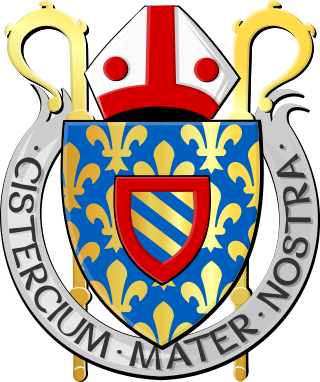
The Cistercians, officially the Order of Cistercians, are a Catholic religious order of monks and nuns that branched off from the Benedictines and follow the Rule of Saint Benedict, as well as the contributions of the highly-influential Bernard of Clairvaux, known as the Latin Rule. They are also known as Bernardines, after Saint Bernard, or as White Monks, in reference to the colour of their cowl, as opposed to the black cowl worn by Benedictines.

The Monasterboice ruins are the remains of an early Christian monastic settlement in County Louth in Ireland, north of Drogheda. The ruins are a national monument of Ireland and also give their name to the local village and to a civil parish of the same name.

Waverley Abbey was the first Cistercian abbey in England, founded in 1128 by William Giffard, the Bishop of Winchester.
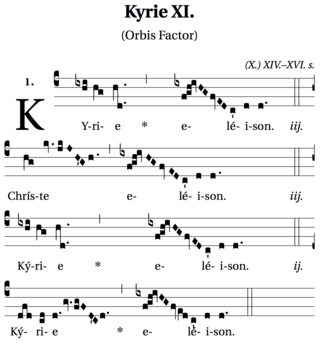
Kyrie, a transliteration of Greek Κύριε, vocative case of Κύριος (Kyrios), is a common name of an important prayer of Christian liturgy, also called the Kyrie eleison.

Kilbeggan is a town in County Westmeath, Ireland. It is in the barony of Moycashel.

Abbeydorney is a village in County Kerry, Ireland. Located 9 kilometres (6 mi) north of the county town of Tralee, the village had a population of 418 as of the 2016 census of Ireland. Abbeydorney falls within the civil parish of O'Dorney, and is sometimes colloquially called by that name.
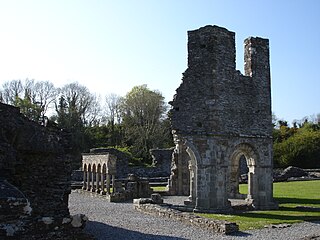
Mellifont Abbey, was a Cistercian abbey located close to Drogheda in County Louth, Ireland. It was the first abbey of the order to be built in Ireland. In 1152, it hosted the Synod of Kells-Mellifont. After its dissolution in 1539, the abbey became a private manor house. This saw the signing of the Treaty of Mellifont in 1603 and served as William of Orange's headquarters in 1690 during the Battle of the Boyne.

Holy Cross Abbey(Mainistir na Croise Naofa) was a Cistercian monastery in Holycross near Thurles, County Tipperary, Ireland, situated on the River Suir. It takes its name from a relic of the True Cross or Holy Rood.

Bective Abbey is a Cistercian abbey on the River Boyne in Bective, County Meath, Ireland.

Boyle Abbey is a ruined Cistercian friary located in Boyle, County Roscommon, Ireland. It was founded by Saint Malachy in the 12th century.

Duiske Abbey National Monument, also known as Graiguenamanagh Abbey, is a 13th-century Cistercian monastery situated in Graiguenamanagh, County Kilkenny in Ireland.
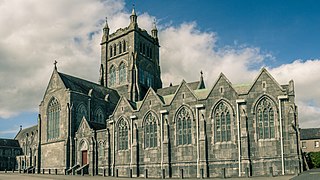
Mount Melleray Abbey is a Trappist monastery in Ireland, founded in 1833. It is situated on the slopes of the Knockmealdown Mountains, near Cappoquin, Diocese of Waterford. It is famous in literature due to Seán Ó Ríordáin's poem Cnoc Mellerí in Eireaball Spideoige (1952). It will close in January, 2025.
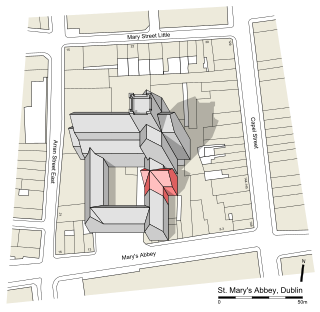
St. Mary's Abbey was a former Cistercian abbey located near the junction of Abbey Street and Capel Street in Dublin, Ireland. Its territory stretched from the district known as Oxmanstown down along the River Liffey until it met the sea. It also owned large estates in other parts of Ireland. It was one of several liberties that existed in Dublin since the arrival of the Anglo-Normans in the 12th century, which gave it jurisdiction over its lands.
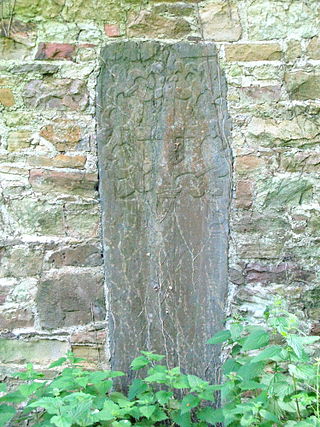
Inislounaght Abbey, also referred to as Innislounaght, Inislounacht and De Surio, was a 12th-century Cistercian settlement on the river Suir, near Clonmel in County Tipperary, Ireland. It was originally dedicated to the Blessed Virgin.
Donnchad Ua Cerbaill or Donnchadh Ó Cearbhaill, king of Airgíalla, fl. c. 1130–1168.
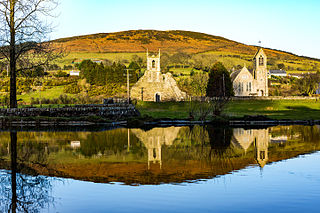
Baltinglass Abbey is a ruined medieval Cistercian abbey in Baltinglass, County Wicklow, Ireland. Founded by Diarmait Mac Murchada in 1148, the abbey was suppressed in 1536. It is today a National Monument.

Monasteranenagh Abbey is a medieval friary and national monument located in County Limerick, Ireland. It is in the civil parish of Monasteranenagh.

David Mac Cerbaill, O.Cist, was Archbishop of Cashel from 1254 until his death.


















